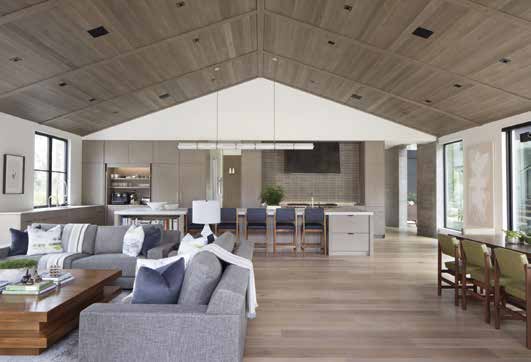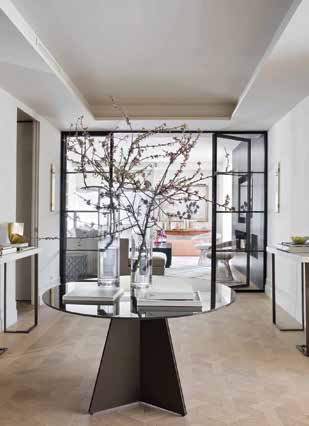Open concept, that’s what everyone wants right? But is it the right concept for you? Open floorplans are high on the “must-have” list when shopping for a new home, and they’re a major reason why people undertake major remodeling projects. Let’s explore open concept movement and the positives and negatives as it relates to your lifestyle.
When used in residential architecture, “Open Concept” refers to two or more traditional-use spaces that are joined together to form a larger space when the partition walls have been removed. This has been the dominant architectural and construction trend since the nineties, but really, it began in the fifties when mid-century modern floor plans began appearing.

Pre-World War II, most homes had a very basic floor plan with a hallway serving as the conduit to each room. Each room had its own specific purpose. The kitchen, often, was placed in the back of the house because it was viewed as a service area not meant for socializing. How times have changed. The kitchen is now the center of social activity.
This shift happened in the post-war years when formality gave way to a more casual attitude mandated by baby boomer and young, growing families with children. As families grew larger, space became a premium. Homes no longer had the luxury of libraries or studies. Innovations in construction materials also made the Open Concept floor plans more practical as it became easier to build large, open rooms that didn’t need walls to support the ceiling/ roof.
Which brings us to the present, where you can turn on any HGTV renovation show and make a drinking game out of how many walls the designer/hosts suggest knocking down. No longer is it enough for just the kitchen and family rooms to be open to one another. The desire for many is to join the kitchen, family room, dining room, and even the living room to make one giant, communal living space or “great room.”
Open Concept floor plans have also prompted kitchen design updates. Appliances are out of sight and as integrated as possible. The modern induction cooktop is back in style as it can appear almost invisible depending on the stove top. Kitchen cabinetry is refined and looks more like built-ins. There are even ways to hide the sink when needed. Essentially, kitchens are looking less like kitchens and more like dining rooms. Clients are even asking for a “messy” kitchen behind their real kitchen. But how “open” is too open? Let’s explore the pros and cons.

CONS
EVERYTHING becomes a focal point Furnishings in an open concept home call for everything to coordinate, and changing just one thing can make you feel the need to address everything. If you have separate rooms, on the other hand, you have so much more freedom to create a different look in each space. Even painting walls becomes a challenge.
Lack of coziness
Opening up your living space connects everyone in your family to create a fun environment but it can also reduce the amount of privacy and coziness. Having little nooks and crannies adds character and a sense of warmth.
Lack of focus
If all the rooms open up to one another, it can make it a challenge for your children to concentrate on homework with all the distractions. You can forget about watching TV while cooking dinner if the open floor plan means junior is doing homework at the kitchen table.
Unpleasant smells
Those cooking smells that are so inviting at dinner time waft through your entire living space and can permeate your furniture and rugs. That’s right, an open-concept floor plan makes it more difficult to trap and contain pungent aromas in the kitchen.
Clutter
There’s no escaping clutter. If dinner was just cooked, there’s no getting away with leaving the dishes until morning. And having less wall space means fewer storage opportunities. So, be honest with yourself. Are you less than tidy? In an open-concept home, everything is on view. So, if loose items aren’t constantly being tucked away, they will stick out like sore thumbs.
Sound
As we all know, noise travels and should be absorbed by surfaces. So, if there are no walls to absorb the sound, it can get loud. Every rattle and hum from the fridge rumbles. And then there’s the knock of the dishwasher and the sound of the “rated mature” television show traveling freely throughout the living space.
Bigger utility bills
Fewer interior walls makes it more challenging to keep your home cool in the summer and warm in the winter. There are ways this can be done, but remember that large, open spaces can affect utility costs.
Art and Family Photos
If you’re a family that loves to hang art, whether Van Gogh or Junior’s latest masterpiece, no walls means no place to hang art. Also, an open concept typically results in one color for the whole space, which can be a bit boring.
PROS
There truly are many advantages to an open-concept home, and it is no wonder that open floor plans are so popular.
Traffic Flow
Without doors to open and close and no walls to hinder traffic, people can move through space unhindered.

Improved family communication
Without walls, it’s possible to talk to one another across rooms and not have to yell.
Improved real estate value
Okay, this is a big one. In almost every instance, an open floor plan is highly desirable and increases your home’s value to prospective buyers.
Easier to watch the kids
Parents cooking in the kitchen can easily supervise children playing or doing homework in the other, visible rooms.
Layout flexibility
Without partition walls, it is easy to reconfigure furnishings and accessories. If you get a new couch in the family room, perhaps you can reuse the old couch in a different area because it’s no longer “right” for just that one room.
Spaces can be multifunctional
Rooms can serve as a family room, a recreation room, a home office, or an entertainment space depending on your needs of the moment.
It just looks good
An open-concept floor plan just looks great. It makes homes not feel so boxy and just lends itself to a more luxurious lifestyle. Still convinced an open concept is for you? By all means, knock down those walls. But don’t be afraid to compromise. I recently completed an open floor plan in an L shape to create just the right amount of separation for my clients while still keeping the open floor plan they wanted. It was the perfect solution for them. What’s the perfect solution for you?

Maya Williams
MAYA WILLIAMS DESIGN
818-854-6031
maya@mayawilliamsdesign.com
facebook.com/MayaWilliamsDesign
instagram/mayawilliamsdesign


